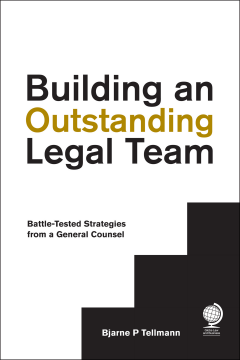
Additional Information
Book Details
Abstract
In this practical “how to” guide, Bjarne P Tellmann, General Counsel and SVP of Pearson, draws upon more than 20 years of leading top legal organisations across Europe, Asia and the United States to provide a structured plan for upgrading your legal team in an age of disruption.
The challenge: In an era of exponential change, the role of the general counsel (GC) has become one of the most complex, intense and challenging in the corporate world. GCs, must lead, unify and inspire diverse groups of people across the globe with subtlety and diplomacy. The stakes have never been higher and the consequences of getting it wrong can be existential. GCs must react to these challenges with ever-fewer resources and at a time when the legal profession itself is undergoing disruption.
The response: To succeed in this “new normal”, GCs must become their own chief executives. They must lead, communicate, inspire, build cultures, manage talent, formulate and execute strategies, ensure efficacy, anticipate and manage risk and manage quality control – all in addition to being top-notch lawyers. This book gives GCs the battle plan they need to get there in three parts. Part I looks at the “hardware”, including how to assess risk, design winning teams, optimise spend, choose the best partners, and select smart technology. Part II focuses on the “software”, including how to nurture a world-class legal culture and develop talent. Part III considers two highly critical threads that weave their way through the transformational journey: change management and the need to develop a strategic roadmap.
While primarily aimed at in-house legal leaders, the book will also have broader appeal, as many of the approaches and principles are universal. In particular, law firm partners, lawyers at all levels and leaders from other support functions will find much to draw upon, as will government lawyers, suppliers to the legal industry, such as alternative service providers and technology outfits and consultants. The book will also be of interest to academics and law students teaching and taking courses on in-house legal practice.
Table of Contents
| Section Title | Page | Action | Price |
|---|---|---|---|
| Front cover | 1 | ||
| Title | 2 | ||
| Copyright | 5 | ||
| Table of contents | 10 | ||
| Foreword | 14 | ||
| Acknowledgements | 16 | ||
| About the author | 20 | ||
| Part A: Setting the scene | 22 | ||
| Introduction | 24 | ||
| The changing context | 32 | ||
| Part B: The hardware | 52 | ||
| Talent and risk assessments | 54 | ||
| Designing an integrated team structure | 82 | ||
| Law firms | 112 | ||
| Alternative legal services providers | 140 | ||
| Selecting the right partners | 156 | ||
| Technology | 182 | ||
| Part C: The software | 204 | ||
| Culture | 206 | ||
| The generational context and the rise of the millennials | 236 | ||
| Leadership skills | 254 | ||
| Part D: Critical threads | 284 | ||
| Change management | 286 | ||
| Strategic direction | 304 | ||
| Part E: Conclusion | 318 | ||
| Concluding remarks | 320 | ||
| Chapter notes | 324 | ||
| Further reference material | 338 | ||
| Index | 350 |
